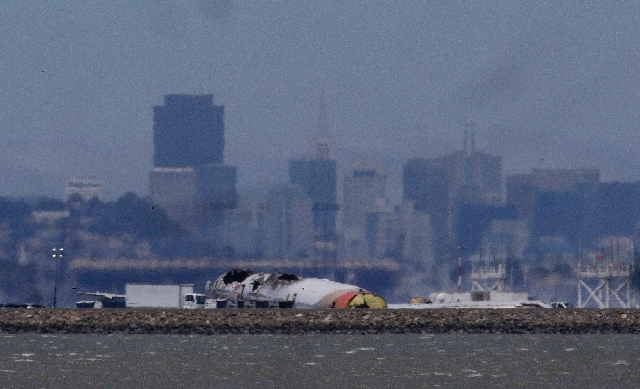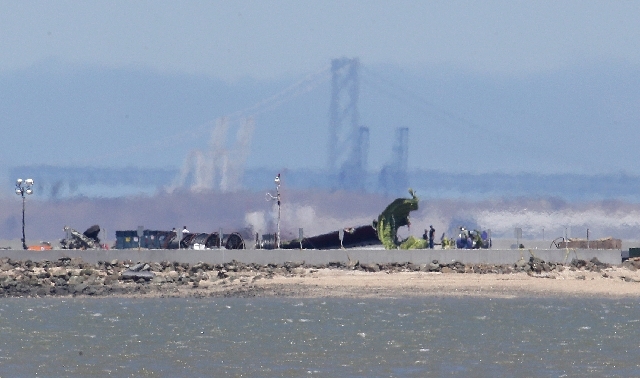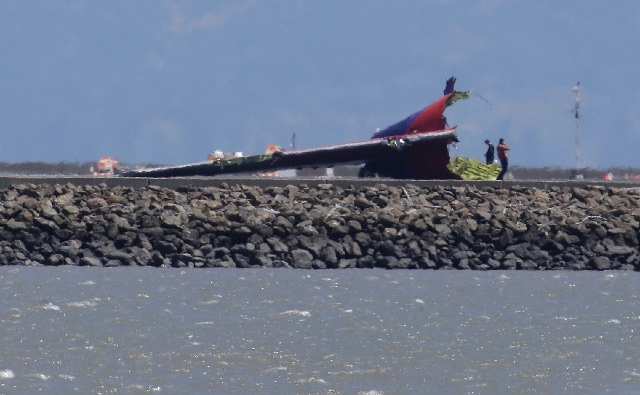Investigators look into pairing of Asiana pilots
SAN FRANCISCO — As Flight 214 descended over San Francisco Bay, both Asiana Airlines pilots were trying something new.
In the left seat of the cockpit sat Lee Gang-kuk, a 46-year-old pilot with just 35 hours of experience flying a Boeing 777 who was landing the big jet for his first time at San Francisco International Airport. At his right was Lee Jeong-Min, a trainer making his first trip as an instructor pilot.
While the two men had years of aviation experience, this mission involved unfamiliar duties, and it was the first time they had flown together. The flight came to a tragic end when the airliner crash-landed Saturday, killing two passengers and injuring many others.
National Transportation Safety Board chairman Deborah Hersman said Wednesday the pilot told investigators he was blinded by a light at about 500 feet, which would have been 34 seconds before impact and the point at which the airliner began to slow and drop precipitously. She said lasers have not been ruled out.
It was unclear, however, if the flash might have played a role in the crash.
The agency also said that after the crash landing, passengers were told to stay seated while the crew contacted the control tower, and people did not begin fleeing the aircraft until 90 seconds later when a fire was spotted outside the plane.
At that point, the doors were opened and escape slides were inflated. Two flight attendants were pinned by slides that inflated inside during the impact.
Experts say investigators trying to piece together what went wrong will consider the report about the light and many other factors including the pairing of the pilots, who were assigned to work together through a tightly regulated system developed after several deadly crashes in the 1980s that were blamed in part on inexperience in the cockpit.
The NTSB “is definitely going to focus on what type of policy Asiana had in terms of crew pairing,” former NTSB Chairman James Hall said. “That’s what the airline needs to do, be responsible so that in the cockpit you’re matching the best people, especially when you’re introducing someone to a new aircraft.”
Pilots are typically paired by management and are not allowed to choose their partners in the cockpit.
Massachusetts Institute of Technology aeronautics professor Mary Cummings said it’s common for two commercial pilots to be assigned to the same flight without ever working together before. Airlines have standardized, formal procedures to facilitate teams of strangers.
The military tries to have crews work together more permanently, she said.
“Research would tell you that crew pairing with the same people over longer periods of time is safer,” she said. “When two people fly together all the time, you get into a routine that’s more efficient. You have experience communicating.”
Jeff Skiles, a US Airways first officer, said that with the right training it should not matter if a pilot new to a plane is paired with a pilot making his first trip as a training captain.
“Everybody had to have their first time,” Skiles said. “You can’t show up and have 500 hours experience in aircraft.”
Skiles was the co-pilot of the “Miracle on the Hudson” jet that lost thrust in both engines after colliding with a flock of geese. The skillful flying of captain Chesley “Sully” Sullenberger and teamwork between Skiles and Sullenberger was credited for a near-perfect water landing on the Hudson River between New York and New Jersey that saved the lives of all aboard.
The January 2009 accident happened after the pilots had been paired together only four days.
Details emerging from pilot interviews, cockpit recorders and control-tower communications indicate that Lee Gang-kuk, who was halfway through his certification training for the Boeing 777, and his co-pilot and instructor, Lee Jeong-Min, thought the airliner’s speed was being controlled by an autothrottle, which was set for 157 mph.
Inspectors found that the autothrottle had been “armed,” or made ready for activation, Hersman said. But investigators are still determining whether it had been engaged.
When the pilots realized the plane was approaching the waterfront runway too low and too slow, they both reached for the throttle. Passengers heard a loud roar as the plane revved up in a last-minute attempt to abort the landing.
The two pilots at the controls during the accident had also been in the cockpit for takeoff. Then they rested during the flight while a second pair of pilots took over. The two pairs swapped places again about 90 minutes before landing, giving the trainee a chance to fly during the more challenging approach phase.
The investigation is ongoing, and Hersman cautioned against speculating about the cause. But she stressed that even if the autothrottle malfunctioned, the pilots were ultimately responsible for control of the airliner.
“Let me be very clear: The crew is required to maintain a safe aircraft,” she said Tuesday.
Airspeed is “one of the very critical things that needs to be monitored on the approach to landing, she added. “So we need to understand what was going on in the cockpit and on the aircraft.”
A third pilot was in the cockpit jumpseat to monitor the landing, Hersman said, but he told investigators he couldn’t see the approach to the runway because the tail was so low that the aircraft’s steep angle blocked his view of the ground.
The tail ultimately smashed into a seawall and broke off before the rest of the fuselage hit and ground and spun across the tarmac.
Crash survivor Brian Thomson, who was returning from a martial arts competition in South Korea and walked away physically unscathed, said he’s not concerned about lack of experience in the cockpit.
“At some point you have to start at hour one, hour two. It’s just natural. Everyone starts a career someway, somehow. Starts a new plane someway, somehow. They have to have training,” he said.
The Air Line Pilots Association, a union representing more than 50,000 pilots at 33 American and Canadian airlines, complained that the NTSB is releasing incomplete, out-of-context information that could lead to unfair characterizations of Asiana’s pilots.
“Without the full body of facts surrounding a catastrophic event, partial or incomplete information can lead to erroneous conclusions and, in turn, skew the perception of individuals’ behavior. This could then lead to misguided assessments of the crew’s intentions and actions,” the union said in a statement.
Hersman said the NTSB is representing passengers and trying to be transparent.
In the U.S., drug and alcohol tests are standard procedure after air accidents, the same is not required for foreign pilots. Hersman said the Asiana pilots had not undergone any tests.
The flight originated in Shanghai and stopped over in Seoul before making the nearly 11-hour trip to San Francisco.
Nearly 20 survivors remained hospitalized Wednesday, and families arrived to care for many of them.
Three flight attendants thrown from the airliner during the accident were among those hurt. One of them has been identified as 25-year-old Maneenat Tinnakul, whose father told the Thairath newspaper the family was given a visa to visit their daughter in San Francisco. He said Maneenat suffered a minor backache.
Another flight attendant, identified as Sirithip Singhakarn, was reportedly in an intensive care unit.
Meanwhile, fire officials continued their investigation into whether one of their trucks might have run over one of the two Chinese teenagers killed in the crash. The students, Wang Linjia and Ye Mengyuan, were part of a larger group headed for a Christian summer camp with dozens of classmates. Several of those camps have been canceled and the students are returning home.
———
THE ASSOCIATED PRESSs Joan Lowy in Washington and Haven Daley in Scotts Valley, Calif., contributed to this report.
























